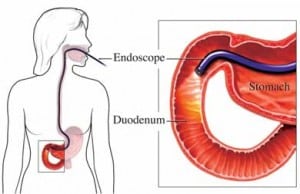 An Upper Endoscopy (GI Series) series is an exam of your upper digestive tract which includes the area from your mouth to the start of your small intestine. X-rays or endoscopy (a tiny camera on the end of a long, flexible tube) is used to view, diagnose and, sometimes, treat conditions that affect the esophagus, stomach and beginning of the small intestine (duodenum)
An Upper Endoscopy (GI Series) series is an exam of your upper digestive tract which includes the area from your mouth to the start of your small intestine. X-rays or endoscopy (a tiny camera on the end of a long, flexible tube) is used to view, diagnose and, sometimes, treat conditions that affect the esophagus, stomach and beginning of the small intestine (duodenum)
What problems can an Upper Endoscopy (GI Series) detect?
This test helps your doctor find problems and certain diseases such as:
- ulcers
- abnormal growths
- precancerous conditions
- bowel obstruction
- inflammation
- hiatal hernia
How is an Upper Endoscopy (GI Series) performed?
Patients may receive a local, liquid anesthetic that is gargled or sprayed on the back of the throat. The anesthetic numbs the throat and calms the gag reflex. An intravenous (IV) needle is placed in a vein in the arm if a sedative will be given. Sedatives help patients stay relaxed and comfortable. While patients are sedated, the doctor and medical staff monitor vital signs.
During the procedure, patients lie on their back or side on an examination table. An endoscope is carefully fed down the esophagus and into the stomach and duodenum. A small camera mounted on the endoscope transmits a video image to a video monitor, allowing close examination of the intestinal lining. Air is pumped through the endoscope to inflate the stomach and duodenum, making them easier to see. Special tools that slide through the endoscope allow the doctor to perform biopsies, stop bleeding, and remove abnormal growths.
Recovery from Upper Endoscopy
After upper GI endoscopy, patients are moved to a recovery room where they wait about an hour for the sedative to wear off. During this time, patients may feel bloated or nauseated. They may also have a sore throat, which can stay for a day or two. Patients will likely feel tired and should plan to rest for the remainder of the day. Unless otherwise directed, patients may immediately resume their normal diet and medications.
Some results from upper GI endoscopy are available immediately after the procedure. Your Suburban Gastroenterology doctor will often share results with the patient and/or family after the sedative has worn off. Biopsy results are usually ready in a few days.
What are the risks associated with upper GI endoscopy?
- Risks associated with upper GI endoscopy include
- abnormal reaction to sedatives
- bleeding from biopsy
- accidental puncture of the upper GI tract
Patients who experience any of the following rare symptoms after upper GI endoscopy should contact us immediately:
- swallowing difficulties
- throat, chest, and abdominal pain that worsens
- vomiting
- bloody or very dark stool
- fever
Helpful Links

